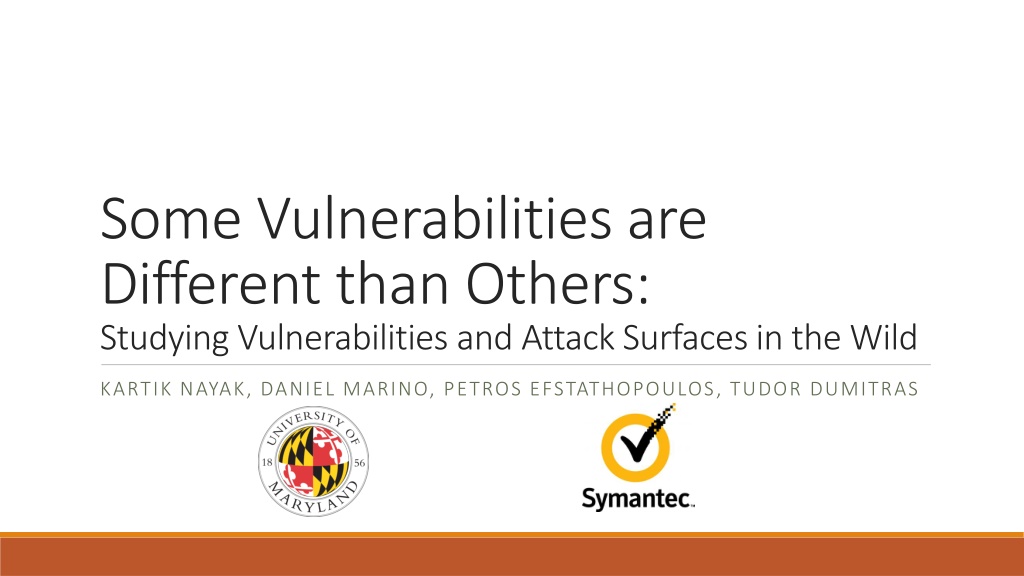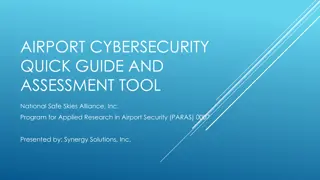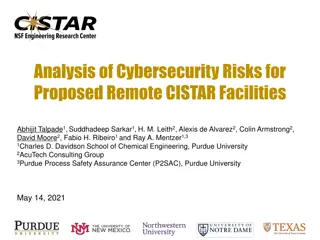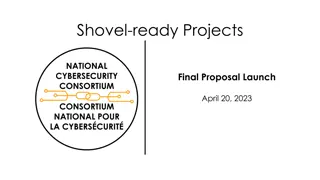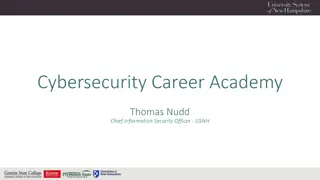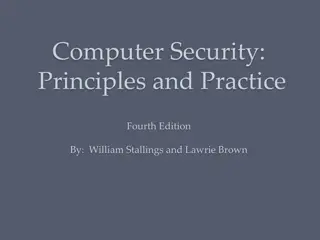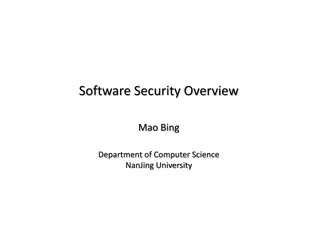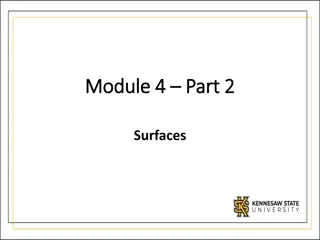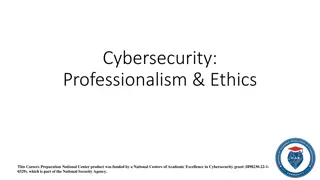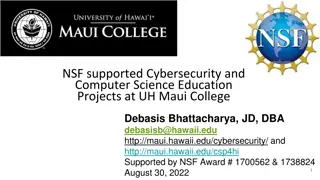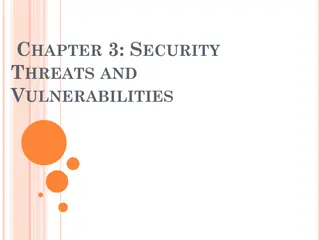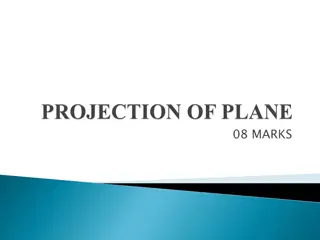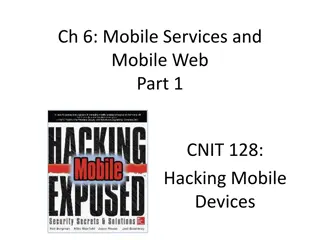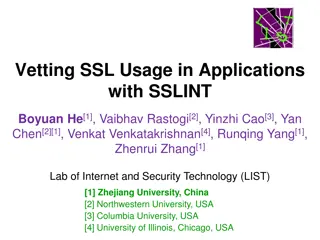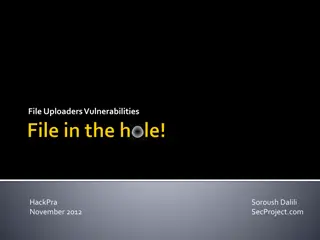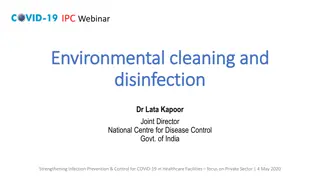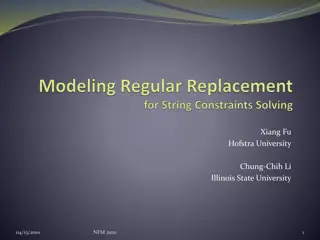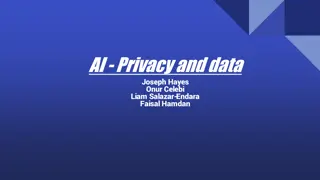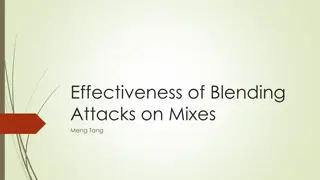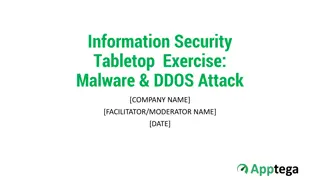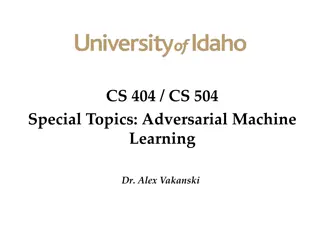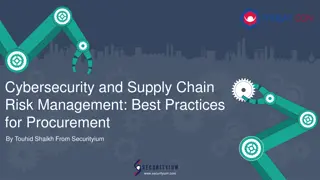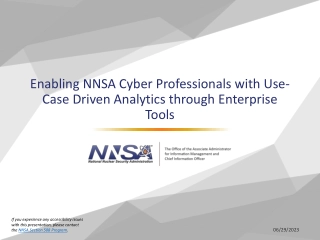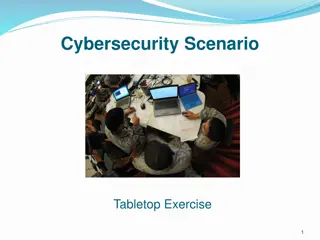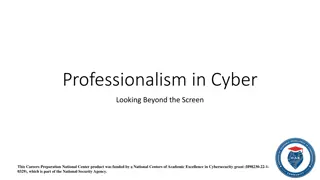Understanding Vulnerabilities and Attack Surfaces in Cybersecurity
Exploring the complexities of system security metrics, this study delves into the challenges of measuring and improving security techniques. It highlights the limitations of current metrics, emphasizing the importance of evaluating the impact in deployment environments. By examining various vulnerabilities and attack surfaces, the research sheds light on the crucial role of effective data analysis in enhancing cybersecurity strategies.
Download Presentation

Please find below an Image/Link to download the presentation.
The content on the website is provided AS IS for your information and personal use only. It may not be sold, licensed, or shared on other websites without obtaining consent from the author. Download presentation by click this link. If you encounter any issues during the download, it is possible that the publisher has removed the file from their server.
E N D
Presentation Transcript
Some Vulnerabilities are Different than Others: Studying Vulnerabilities and Attack Surfaces in the Wild KARTIK NAYAK, DANIEL MARINO, PETROS EFSTATHOPOULOS, TUDOR DUMITRAS
Data Breaches and Cyber Attacks are Common! Recent iCloud bug, iOS vulnerability Adobe Reader media API vulnerability Conficker worm Newer security technologies introduced Address space layout randomization, Data execution prevention Windows Vista Sandboxing/protected mode Adobe Reader 10, Internet Explorer 7 2 9/21/2024
Can we measure the impact of any of the system-security techniques? 3 9/21/2024
Effectiveness of Current Security Metrics CVSS scores: Do not reflect creation of proof-of-concept exploits [Bozorgi et al. 10] CVSS scores: Do not reflect exploits in the wild [Allodi et al. 13] Classical defect prediction metrics (e.g. code complexity, churn, coverage, etc.): Low recall when predicting vulnerabilities [Zimmermann et al. 10] Attack surface [Manadhata et al. 10]: Difficult to assess in the field 4 9/21/2024
"If you cannot measure it, you cannot improve it." --Lord Kelvin 5 9/21/2024
In a Nutshell Existing security metrics Reflect developer s view Not deployment environment Our security metrics Deployment environment Evaluate impact of system-security techniques IE 5 vs Office 2000 Number of vulnerabilities: IE 5 = 3 x Office 2000 Exploited vulnerabilities: IE 5 = Office 2000 6 9/21/2024
Outline Current metrics and their limitations Proposed metrics Data analysis approach Data analysis If/whether metrics how often metrics when metrics Implications Conclusion 7 9/21/2024
Current Metrics and their Limitations Number of vulnerabilities Common Vulnerability Scoring System (CVSS) Impact on confidentiality, integrity, availability Access complexity, Access vector, etc Scores given by security vendors Attack Surface [Howard et al. 03, Manadhata et al. 11, Kurmus et al. 13] Set of ways in which an adversary can enter the system and cause damage Requires access to source code These metrics do not reflect security in the field CVSS BaseScore = ((0.6 * Impact) + (0.4 * Exploitability) - 1.5) * f(Impact) Users can modify attack surface (e.g. installing software, reconfiguring services) Do not capture i. Likelihood of attacks ii. Severity [Allodi et al. 12, Allodi 13, Bozorgi et al. 10] Hard to measure 8 9/21/2024
Proposed Metrics if/whether a vulnerability is exploited? Exploitation ratio Count of vulnerabilities exploited how often are products attacked? Exercised attack surface Attack volume when are attacks against vulnerabilities seen? Per product Per host These metrics are Based on field data i.e. computed on real hosts Computed per product or per host 9 9/21/2024
Data Sets used National Vulnerability Database CVE, vulnerable s/w list Symantec Signatures CVE, signature IPS signatures AV signatures Obtained by screen-scraping Symantec webpages Links: ter.ps/azlisting, ter.ps/attacksign Worldwide Intelligence Network Environment (WINE) IPS telemetry machine ID, attack_time, signature Binary Reputation machine ID, binary, time 300 million IPS entries over 6 million hosts from 2009 to 2014 Only consider network-based attacks 10 9/21/2024
Data Analysis Approach (1) CVE-1 CVE-2 .. CVE-5 .. CVE-10 Product A: Product A Sign A, CVE-2 Number of exploited vulnerabilities: 3 Sign B, CVE-3 Exploitation Ratio: 0.3 Sign C, CVE-3 Sign D, CVE-8 Product B: CVE-11 CVE-12 .. CVE-15 Sign E, CVE-12 Number of exploited vulnerabilities: 2 Product B Sign F, CVE-14 Exploitation Ratio: 0.4 Symantec Signatures Combined NVD 11 9/21/2024
Data Analysis Approach (2) Mach-1, 12th Jan 2014, Sign A Mach-1, 13th Jan 2014, Sign B Mach-1, 16th Jan 2014, Sign A Mach-1, 17th Jan 2014, Sign E Mach-1, 20th Jan 2014, Sign F WINE Mach-1, Product-A, 12th Jan 2014, Sign A, CVE-2 Mach-1, Product-A, 13th Jan 2014, Sign B, CVE-3 . IPS Telemetry Compute WINE Binary Reputation Exercised Attack Surface, Attack Volume Mach-1, Product A, 1st Jan 2014 Mach-1, Product B, 1st Jan 2014 12 9/21/2024
Products Analyzed Microsoft Windows XP, Vista, Windows 7 Microsoft Office 2000, 2003, 2007, 2010 Internet Explorer Versions: 5 8 Adobe Reader Versions: 5 11 Popular products and hence good candidates 13 9/21/2024
Outline Current metrics and their limitations Proposed metrics Data analysis approach Data analysis If/whether metrics how often metrics when metrics Implications Conclusion 14 9/21/2024
If/Whether a Vulnerability is Exploited? ?????? ?? ????????? ??????????????? ?????? ?? ????????? ??????????????? Exploitation ratio = Count of vulnerabilities exploited in the wild Per product metrics CVE-1 CVE-2 .. CVE-5 .. CVE-10 Sign A, CVE-2 Product A: Sign B, CVE-3 Product A Number of exploited vulnerabilities: 3 Sign C, CVE-3 Exploitation Ratio: 0.3 Sign D, CVE-8 15 9/21/2024
Cyber attackers have had less time to attack newer products? 90% of vulnerabilities are attacked within 94 days after disclosure Analysis using Symantec signatures, OSVDB and WINE Most vulnerabilities are exploited within 30 days after disclosure Result also confirmed in [Frei 09, Bilge et al. 12, Microsoft Security Intelligence Report 14] 16 9/21/2024
Variation of Exploitation Ratio Between Products On an average, only 15% of the vulnerabilities were exploited The exploitation ratio varies between different products Adobe Reader < Microsoft Office IE 5 and Office 2000 have same number of exploited vulnerabilities (27), but the exploitation ratio of Office 2000 is thrice that of IE 5 Product Exploitation Ratio Exploited vuln Office 2000 0.32 27 Office 2003 0.35 43 Office 2007 0.27 18 Office 2010 0.25 5 Adobe Reader 8 0.16 29 Adobe Reader 9 0.11 29 Adobe Reader 10 0.08 13 Adobe Reader 11 0.06 5 Internet Explorer 5 0.12 27 Demonstrates the pitfall of using number of vulnerabilities as a security measure 17 9/21/2024
Newer Versions have Fewer Exploited Vulnerabilities Newer versions have fewer exploited vulnerabilities and lower exploitation ratio Adobe Reader 10, 11 < Adobe Reader 8, 9 Windows Vista, Windows 7 < Windows XP Product Exploitation Ratio Exploited vulnerabilities Windows XP 0.21 39 Windows 7 0.07 20 Adobe Reader 8 0.16 29 Newer security technologies introduced Address space layout randomization (ASLR) Data execution prevention (DEP) Sandboxing Commoditization of exploits Adobe Reader 9 0.11 29 Adobe Reader 10 0.08 13 Adobe Reader 11 0.06 5 18 9/21/2024
OS security, as seen by developers OS security, as seen by users 19 9/21/2024
How Often are Vulnerabilities Exploited? Exercised Attack Surface: Number of distinct vulnerabilities that are exploited on a host in a given month Attack Volume: Number of attacks experienced by a host in a given month Per host metrics Mach-1, Product-A, 12th Jan 2014, Sign A, CVE-2 Mach-1, Product-A, 13th Jan 2014, Sign B, CVE-3 Mach-1, Product-A, 14th Jan 2014, Sign B, CVE-3 Mach-1, Product-A, 16th Jan 2014, Sign D, CVE-8 Mach-1, Product-B, 20th Jan 2014, Sign E, CVE-12 Mach-1, Product-B, 24th Jan 2014, Sign E, CVE-12 Mach-1: Exercised Attack Surface: 4 Attack Volume: 6 20 9/21/2024
Exercised Attack Surface for Product Versions Exploited vulnerabilities: Reader < IE Newer security technologies introduced in Reader, IE: Protected Mode Newer security technologies introduced in Vista, Windows 7: ASLR, DEP Reader is easier for cyber criminals to exploit than IE 21 9/21/2024
Variation of Exercised Attack Surface over Time Spikes correspond to attacks on CVE-2009-4324 Apps contribute more to the attack surface than the OS 22 9/21/2024
Can we Reduce Attack Surface? Analyzed OS vulnerabilities with most attacks Services corresponding to 6 out of top 10 OS vulnerabilities could be disabled Others could not be disabled (e.g. vulnerability in files related to the kernel) 23 9/21/2024
When are Vulnerabilities Exploited? How long do machines survive? Survival implies machine not attacked for a vulnerability of an installed product Kaplan-Meier estimator to compute survival probability Accounts for censored data (e.g. hosts may leave our study without being attacked) 24 9/21/2024
Survival of Windows vs Reader vulnerabilities Newer security technologies introduced in Reader 10, 11: Protected Mode 25 9/21/2024
Survival of IE vulnerabilities Newer security technologies introduced in IE 7: Protected Mode 26 9/21/2024
Product Upgrade Lag Product upgrade lag: how long a user continues to use a product after a new version is released Maximum upgrade lag over all versions of the product Upgrade lag: 1 Year Upgrade lag: 3 years Upgrade lag: 5 years Releases version 2 Version 5 Version 4 Version 3 Version 1 installed User upgrades to V2 To V5 To V3 2008 2010 2012 2014 2006 2002 2000 2004 27 9/21/2024
Effect of Product Upgrade Lag on Exercised Attack Surface Does the length of time to upgrade have an effect on attack surface? 28 9/21/2024
Can we measure the impact of any of the system-security techniques? Our metrics show an improvement after Sandboxing/Protectedmode was introduced in Adobe Reader 10 and Internet Explorer 7 Security was a major goal for Windows Vista. Our metrics show an improvement in Windows Vista, Windows 7 after ASLR, DEP, UAC were introduced 29 9/21/2024
Implications Low exploitation ratio for newer products Cyber criminals feel scarcity of exploits (e.g., budget of $100,000 allocated for purchasing zero-day exploits by the author of blackhole exploit kit) Exploit kits are rented/sold in the market Policies in enterprises (BYOD) Attack surface varies between different hosts Takes user behavior into account (e.g. upgrade lag) Qualitative analysis ASLR, DEP, UAC in Windows Vista, Windows 7 Protected mode/Sandboxing in Adobe Reader 10, Internet Explorer 7 30 9/21/2024
Conclusion Few vulnerabilities are exploited in the wild Number of vulnerabilities does not correspond to number of exploited vulnerabilities The average exercised attack surface for Windows, IE and Reader decreases with newer versions Few vulnerabilities (CVE-2009-4324) have disproportionate number of attacks Users using Reader are attacked more in comparison to Windows and IE Quicker upgrades correspond to reduced attack surface 31 9/21/2024
THANK YOU kartik@cs.umd.edu 32 9/21/2024
